The global thermoformed tray market is projected to grow from USD 12.6 billion in 2025 to approximately USD 31.5 billion by 2035, recording an absolute increase of USD 18.8 billion over the forecast period. This translates into a total growth of 149.2%, with the market forecast to expand at a CAGR of 9.6% between 2025 and 2035.
The market size is expected to grow by approximately 2.5X during the same period, supported by increasing demand for convenient packaging solutions, growing adoption across food service industries, and rising requirements for hygienic packaging solutions across global retail and industrial sectors.
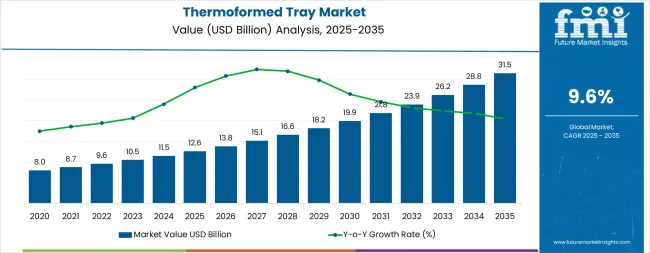
Between 2025 and 2030, the thermoformed tray market is projected to grow from USD 12.6 billion to USD 20.2 billion, increasing by USD 7.6 billion, representing 40.4% of the total forecast growth. This growth will be driven by rising demand for ready-to-eat meal packaging, consumer preference for convenient food solutions, and expanding availability of thermoformed trays in retail and food service sectors. From 2030 to 2035, the market is expected to expand further from USD 20.2 billion to USD 31.5 billion, adding USD 11.2 billion, or 59.6% of the total growth.
Key factors during this period will include advancements in barrier protection technologies, innovative design features, and premium packaging solutions. The focus will be on food safety, hygienic packaging, and enhanced functional characteristics like temperature resistance. Between 2020 and 2024, the market grew due to increasing recognition of thermoformed trays' role in providing safe, convenient food storage with improved handling and food quality preservation.
The packaging industry is the largest contributor, accounting for around 35-40%. Thermoformed trays are widely used in various sectors due to their lightweight, durable, and customizable nature. They are ideal for packaging food, electronics, medical devices, and consumer goods, providing excellent protection during transit and reducing product damage.
The ability to create tailored shapes and sizes for specific products makes thermoformed trays highly versatile, driving their demand across industries. In the food and beverage market, contributing approximately 25-30%, these trays are commonly used for ready-to-eat meals, fresh produce, snacks, and takeout containers.
The consumer goods market, contributing about 15-20%, uses thermoformed trays for packaging a wide variety of products such as toys, electronics, and personal care items. The flexibility and customization options offered by thermoformed trays make them an ideal solution for this sector.
The medical device market, accounting for around 10-12%, relies on thermoformed trays to package sensitive items like surgical tools and diagnostic equipment, ensuring sterility and protection. The electronics market, with a share of 5-8%, also benefits from thermoformed trays for packaging fragile electronics like smartphones and computer components, offering superior protection during shipping.
| Metric | Value |
|---|---|
| Estimated Value in (2025E) | USD 12.6 billion |
| Forecast Value in (2035F) | USD 31.5 billion |
| Forecast CAGR (2025 to 2035) | 9.6% |
Market expansion is being supported by the increasing global demand for convenient packaging solutions and the corresponding shift toward hygienic packaging that can provide superior protective outcomes while meeting consumer requirements for safety assurance and reliable food storage processes. Modern consumers are increasingly focused on incorporating packaging solutions that can enhance food freshness while satisfying demands for durable, consistently performing packaging and optimized handling practices. Thermoformed trays' proven ability to deliver protection benefits, food safety, and diverse application possibilities makes them essential products for food-service professionals and quality-conscious retailers.
The growing emphasis on food preservation and operational efficiency is driving demand for high-quality thermoformed trays that can support distinctive packaging outcomes and comprehensive safety positioning across fresh food packaging, ready meal applications, and specialty food categories. Consumer preference for products that combine functional excellence with convenience characteristics is creating opportunities for innovative implementations in both traditional and emerging food service applications. The rising influence of food safety standards and hygienic packaging initiatives is also contributing to increased adoption of thermoformed trays that can provide authentic safety benefits and reliability characteristics.
The market is segmented by material type, product type, end-use industry, and region. By material type, the market is divided into plastic, paper-based, aluminum, and biodegradable materials. Based on product type, the market is categorized into compartment trays, flat trays, deep trays, shallow trays, and custom trays.
By end-use industry, the market includes food & beverage, healthcare & medical, electronics, retail, and other industries. Regionally, the market is divided into North America, Europe, Asia Pacific, Latin America, Middle East & Africa, and other regions.
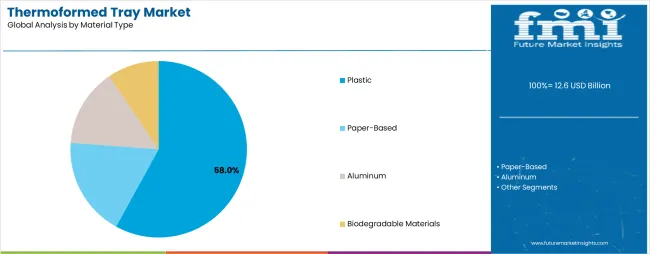
The plastic trays segment is projected to account for 58% of the thermoformed tray market in 2025, reaffirming its position as the leading material category. Food service operators and retailers increasingly utilize plastic trays for their superior barrier characteristics, established clarity properties, and essential functionality in food packaging applications across diverse retail categories. Plastic trays' standardized performance characteristics and proven packaging effectiveness directly address user requirements for reliable food safety and optimal value in commercial applications.
This material segment forms the foundation of modern food packaging patterns, as it represents the format with the greatest commercial acceptance potential and established compatibility across multiple food systems. Retail investments in packaging optimization and safety standardization continue to strengthen adoption among quality-conscious organizations. With users prioritizing food safety and packaging reliability, plastic trays align with both safety objectives and performance requirements, making them the central component of comprehensive food packaging strategies.
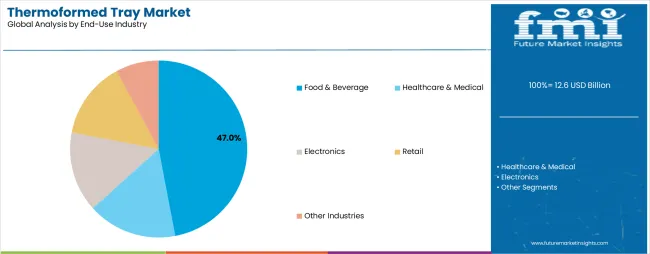
Food & beverage applications are projected to represent 47% of the thermoformed tray market growth through 2035, underscoring their critical role as the primary choice for quality-focused retailers seeking superior packaging benefits and enhanced food safety credentials. Food service operators and fresh food handlers prefer thermoformed trays for their enhanced hygiene standards, proven convenience superiority, and ability to maintain exceptional protective profiles while supporting long-term usage during food distribution experiences. Positioned as essential products for discerning retailers, food packaging offerings provide both functional excellence and safety advantages.
The segment is supported by continuous improvement in food packaging technology and the widespread availability of established manufacturing infrastructure that enables quality assurance and premium positioning at the retail level. The tray manufacturers are optimizing production methods to support market differentiation and accessible pricing. As packaging technology continues to advance and users seek superior food safety solutions, food & beverage applications will continue to drive market growth while supporting food preservation and hygienic handling strategies.
The thermoformed tray market is advancing rapidly due to increasing food safety consciousness and growing need for convenient packaging choices that emphasize superior protective outcomes across retail segments and food service applications. The market faces challenges, including raw material price volatility, environmental concerns regarding plastic usage, and competition from alternative packaging formats affecting market dynamics. Innovation in alternative materials and specialized product development continues to influence market development and expansion patterns.
The growing adoption of thermoformed trays in ready-to-eat food programs and convenience-focused applications is enabling retailers to develop packaging patterns that provide distinctive protection benefits while commanding premium positioning and enhanced safety characteristics. Ready-to-eat applications provide superior barrier density while allowing more sophisticated food presentation across various retail categories. Users are increasingly recognizing the competitive advantages of thermoformed tray positioning for premium food packaging and safety-conscious retail integration.
Modern thermoformed tray manufacturers are incorporating advanced manufacturing systems, barrier technologies, and quality management protocols to enhance packaging capabilities, improve consumer outcomes, and meet retail demands for food-specific protection solutions. These systems improve tray effectiveness while enabling new applications, including modified atmosphere packaging and specialized configuration programs. Advanced barrier integration also allows manufacturers to support premium market positioning and packaging leadership beyond traditional container operations.
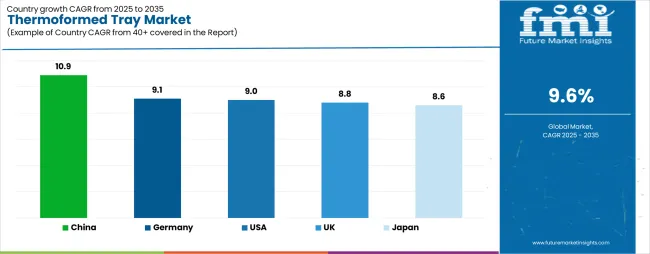
| Country | CAGR (2025-2035) |
|---|---|
| USA | 9.4% |
| Germany | 9.1% |
| UK | 8.8% |
| China | 10.9% |
| Japan | 8.6% |
The thermoformed tray market is experiencing robust growth globally, with China leading at a 10.9% CAGR through 2035, driven by the expanding food service sector, growing retail modernization, and increasing adoption of convenient packaging products. The USA follows at 9.4%, supported by rising ready-to-eat food consumption, expanding retail infrastructure, and growing acceptance of hygienic packaging solutions. Germany shows growth at 9.1%, emphasizing established retail markets and comprehensive food safety development. The UK records 8.8%, focusing on premium packaging products and convenience food expansion. Japan demonstrates 8.6% growth, prioritizing quality packaging solutions and technological advancement.
The report covers an in-depth analysis of 40+ countries, with top-performing countries are highlighted below.
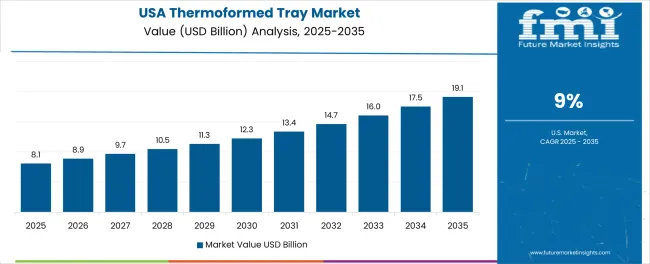
Revenue from thermoformed tray consumption and sales in the USA is projected to exhibit exceptional growth with a CAGR of 9.4% through 2035, driven by the country's rapidly expanding convenience food sector, favorable consumer attitudes toward ready-to-eat solutions, and initiatives promoting food safety optimization across major retail regions. The USA's position as a leading retail market and increasing focus on convenient packaging development are creating substantial demand for high-quality thermoformed trays in both commercial and food service markets. Major food retailers and specialty packaging providers are establishing comprehensive distribution capabilities to serve growing consumer demand and emerging convenience opportunities.
Demand for thermoformed tray products in Germany is expanding at a CAGR of 9.1%, supported by rising food safety sophistication, growing retail precision, and expanding hygienic packaging infrastructure. The country's developing retail capabilities and increasing consumer investment in quality food packaging are driving demand for thermoformed trays across both imported and domestically produced applications. International packaging companies and domestic manufacturers are establishing comprehensive distribution networks to address growing market demand for quality thermoformed trays and food packaging solutions.
The sale of thermoformed tray products in the UK is projected to grow at a CAGR of 8.8% through 2035, supported by the country's mature convenience food market, established hygiene culture, and leadership in quality standards. Britain's sophisticated retail infrastructure and strong support for food safety are creating steady demand for both traditional and innovative thermoformed tray varieties. Leading food retailers and specialty packaging providers are establishing comprehensive operational strategies to serve both domestic markets and growing export opportunities.
Revenue from thermoformed tray products in China is anticipated to grow at a CAGR of 10.9% through 2035, driven by the country's emphasis on retail expansion, food service leadership, and sophisticated production capabilities for food packaging requiring specialized tray varieties. Chinese manufacturers and distributors consistently seek commercial-grade products that enhance food safety and support retail operations for both traditional and innovative food service applications. The country's position as an Asian manufacturing leader continues to drive innovation in specialty thermoformed tray applications and commercial product standards.
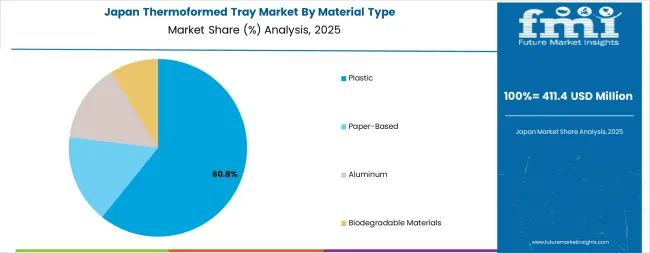
Demand for thermoformed tray products in Japan is projected to expand at a CAGR of 8.6% through 2035, supported by the country's emphasis on quality packaging, food safety standards, and advanced technology integration requiring efficient packaging solutions. Japanese retailers and food handlers prioritize quality performance and precision packaging, making thermoformed trays essential components for both traditional and modern retail applications. The country's comprehensive retail excellence and advancing food service patterns support continued market expansion.
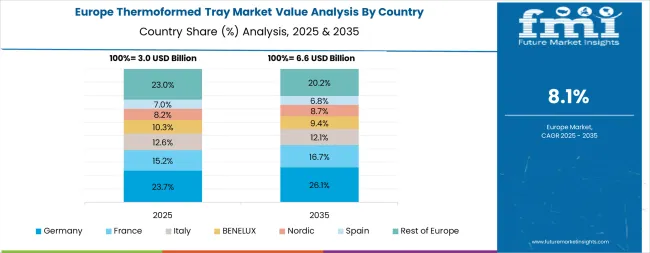
The Europe thermoformed tray market is projected to grow from USD 3.4 billion in 2025 to USD 7.8 billion by 2035, recording a CAGR of 8.7% over the forecast period. Germany leads the region with a 33.0% share in 2025, moderating slightly to 32.5% by 2035, supported by its strong food safety culture and demand for premium, hygienically engineered thermoformed trays.
The United Kingdom follows with 25.0% in 2025, easing to 24.5% by 2035, driven by a sophisticated retail market and emphasis on quality and safety standards. France accounts for 19.0% in 2025, rising to 19.5% by 2035, reflecting steady adoption of convenient packaging solutions and food safety consciousness. Italy holds 10.5% in 2025, expanding to 11.2% by 2035 as retail modernization and specialty food applications grow.
Spain contributes 6.5% in 2025, growing to 7.0% by 2035, supported by expanding food service and convenience food handling. The Nordic countries rise from 4.5% in 2025 to 5.0% by 2035 on the back of strong quality adoption and advanced retail integration. BENELUX remains a stable 1.5% share across both 2025 and 2035, reflecting mature, premium-focused markets.
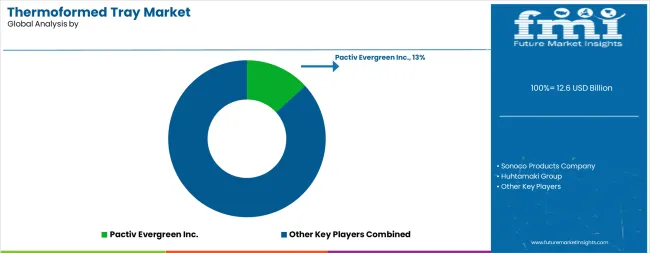
The thermoformed tray market is characterized by competition among established packaging companies, specialized tray manufacturers, and integrated packaging solution providers. Companies are investing in material technologies, advanced manufacturing systems, product innovation capabilities, and comprehensive distribution networks to deliver consistent, high-quality, and functional thermoformed trays. Innovation in barrier enhancement, lightweight production methods, and application-specific product development is central to strengthening market position and customer satisfaction.
Pactiv Evergreen Inc. leads the market with a strong focus on packaging innovation and comprehensive tray solutions, offering premium thermoformed trays with emphasis on functional excellence and packaging heritage. Sonoco Products Company provides specialized manufacturing capabilities with a focus on North American market applications and custom design networks.
Huhtamaki Group delivers integrated packaging solutions with a focus on quality positioning and operational efficiency. Winpak Ltd. specializes in comprehensive barrier packaging with an emphasis on food applications. Placon Corporation focuses on comprehensive retail solutions with advanced manufacturing and premium positioning capabilities.
The success of thermoformed trays in meeting commercial packaging demands, food-driven safety requirements, and quality assurance integration will not only enhance packaging outcomes but also strengthen global retail capabilities. It will consolidate emerging regions' positions as hubs for efficient tray manufacturing and align advanced economies with commercial food packaging systems. This calls for a concerted effort by all stakeholders - governments, industry bodies, suppliers, distributors, and investors. Each can be a crucial enabler in preparing the market for its next phase of growth.
How Governments Could Spur Local Production and Adoption?
How Industry Bodies Could Support Market Development?
How Distributors and Food Service Players Could Strengthen the Ecosystem?
How Suppliers Could Navigate the Shift?
| Items | Values |
|---|---|
| Quantitative Units (2025) | USD 12.6 billion |
| Material Type | Plastic, Paper-Based, Aluminum, Biodegradable Materials |
| Product Type | Compartment Trays, Flat Trays, Deep Trays, Shallow Trays, Custom Trays |
| End-Use Industry | Food & Beverage, Healthcare & Medical, Electronics, Retail, Other Industries |
| Regions Covered | North America, Europe, Asia Pacific, Latin America, Middle East & Africa, Other Regions |
| Countries Covered | United States, Germany, United Kingdom, China, Japan, and 40+ countries |
| Key Companies Profiled | Pactiv Evergreen Inc., Sonoco Products Company, Huhtamaki Group, Winpak Ltd., Placon Corporation, and other leading thermoformed tray companies |
| Additional Attributes | Dollar sales by material type, product type, end-use industry, and region; regional demand trends, competitive landscape, technological advancements in materials engineering, barrier design integration initiatives, quality enhancement programs, and premium product development strategies |
The global thermoformed tray market is estimated to be valued at USD 12.6 billion in 2025.
The market size for the thermoformed tray market is projected to reach USD 31.5 billion by 2035.
The thermoformed tray market is expected to grow at a 9.6% CAGR between 2025 and 2035.
The key product types in thermoformed tray market are plastic, paper-based, aluminum and biodegradable materials.
In terms of end-use industry, food & beverage segment to command 47.0% share in the thermoformed tray market in 2025.






Full Research Suite comprises of:
Market outlook & trends analysis
Interviews & case studies
Strategic recommendations
Vendor profiles & capabilities analysis
5-year forecasts
8 regions and 60+ country-level data splits
Market segment data splits
12 months of continuous data updates
DELIVERED AS:
PDF EXCEL ONLINE
Market Share Breakdown of Thermoformed Tray Market
Thermoformed Containers Market Size and Share Forecast Outlook 2025 to 2035
Thermoformed Skin Packaging Market Size and Share Forecast Outlook 2025 to 2035
Thermoformed Plastics Market Size and Share Forecast Outlook 2025 to 2035
Thermoformed Tubs Market Trend Analysis Based on Material, Shape, End-Users and Regions through 2025 to 2035
Market Share Distribution Among Thermoformed Tubs Manufacturers
Thermoformed Lids Market
Vacuum Thermoformed Packaging Market Size and Share Forecast Outlook 2025 to 2035
Key Companies & Market Share in the Vacuum Thermoformed Packaging Sector
Tray Sealing Machines Market Size and Share Forecast Outlook 2025 to 2035
Tray Dispensers Market Size and Share Forecast Outlook 2025 to 2035
Tray and Sleeve Packing Machines Market Size and Share Forecast Outlook 2025 to 2035
Tray Former Machines Market Size and Share Forecast Outlook 2025 to 2035
Tray Sealer Machines Market Size and Share Forecast Outlook 2025 to 2035
Industry Share & Competitive Positioning in Tray Sealer Machines
Market Share Distribution Among Tray Former Machines Manufacturers
Tray Market Analysis – Growth & Forecast 2024-2034
Tray Liners Market
Tray Packing Machine Market
Tray Loader Market

Thank you!
You will receive an email from our Business Development Manager. Please be sure to check your SPAM/JUNK folder too.
Chat With
MaRIA